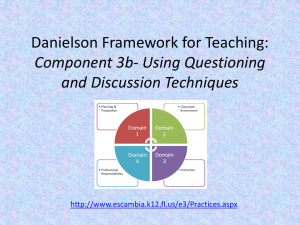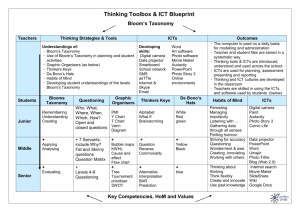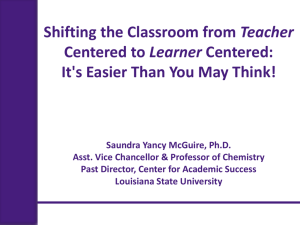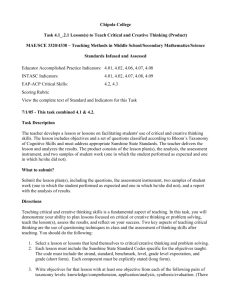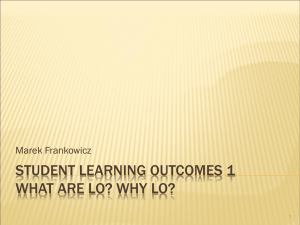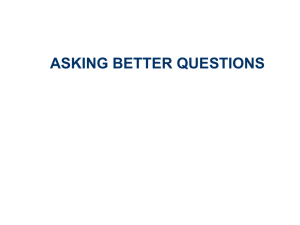using questions
advertisement
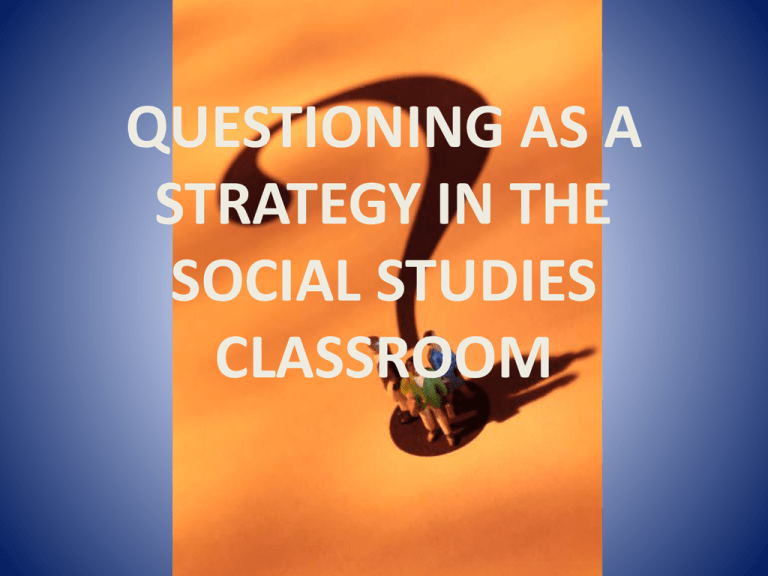
QUESTIONING AS A STRATEGY IN THE SOCIAL STUDIES CLASSROOM Judge a man by his questions rather than by his answers . - Voltaire • To prepare for the future, we must move from the teaching of facts to the teaching of thinking. • Unless we make that transition, we will produce a generation of students ill-prepared to cope with their world. THE TRADITIONAL CLASS DON’T DO ANYTHING FOR YOUR STUDENTS THEY CAN DO FOR THEMSELVES! RESEARCH SAYS. . . . • 75-80% of questions posed in both elementary and secondary classrooms are at the recall or memory level. • In your opinion, what are the 3-4 most important factors contributing to this situation? RESEARCH SAYS. . . . • Most teachers call on students perceived as high achievers more frequently than they call on low achievers. • What do you believe to be 2-3 overriding reasons for this teacher behavior? RESEARCH SAYS. . . . • When teachers ask questions, they typically wait one second or less for students to begin their responses. • Why do you think teachers allow students so little time to begin their responses? RESEARCH SAYS. . . . • Teachers frequently give a student the answer to a question that the student does not answer correctly or immediately. • Suggest 2-3 reasons why many teachers provide the answer rather than attempting to elicit a correct response from the student. RESEARCH SAYS. . . . • Students ask less than 5% of the questions in both elementary and secondary classrooms. • Why do students initiate so few questions? MISSUSES OF QUESTIONING EFFECTIVE QUESTIONING TECHNIQUES PREPARE THE QUESTION PREPARE THE QUESTION - EDIT • Where else in the world would you predict a wall similar to the Berlin Wall might be built today? • Where might a wall similar to the Berlin Wall be built today? • Predict where another Berlin Wall might be built today. EDIT • Create a dialogue between two cousins, who were separated by the Civil War, that describes their situation during the war and the early years of Reconstruction. EDIT • Consider this hypothetical situation: Two cousins were chose to support opposite sides during the Civil War. What might these two discuss on the occasion of their reunion following the end of Reconstruction? Create a dialogue. EDIT • Judge the moral issues represented by each leader. • Judge the moral position upheld by each of the two leaders. • Defend the position of both world leaders as to its morality. • Identify the inconsistencies in the moral position held by each of the two world leaders. POSING THE QUESTION POSE IT WITH CARE • Ask with interest in the STUDENT’S ANSWER • Ask the questions slowly and easily – PUNCTUATE them • Anticipate student responses • Ask and stop WHO WILL RESPOND PROMPT STUDENT RESPONSES - RESEARCH SHOWS. . . • Teachers ask boys more difficult questions and provide longer wait time • Children from poverty and minorities are asked lower level questions • More vocal students dominate the class PROCESS STUDENT RESPONSES REFLECT ON QUESTIONING PRACTICE - Analyze questions - Map respondent selection - Evaluate student response patterns - Examine teacher and student reactions HELP STUDENTS WHO RESPOND INCORRECTLY DEVELOP AUTHENTIC QUESTIONS • Make sure the questions engage students in deeper thinking and not merely prompt them to recall information they have read or been told. I had six honest serving men - They taught me all I knew: - Their names were Where and What and When - and Why and How and Who - - Rudyard Kipling DEVELOP AUTHENTIC QUESTIONS BLOOM’S TAXONOMY LEVEL DEFINITION WHAT THE STUDENT DOES WHAT THE TEACHER DOES WORDS TO HELP YOU ASK QUESTIONS REMEMBER Recall or location of specific bits of information Directs Tells Shows Examines Who, What, When, Where, How, How much, Describe, Define, Match, Select, Choose, Omit Responds Absorbs Remembers Recognizes BLOOM’S TAXONOMY LEVEL DEFINITION UNDER Understanding -STAND communicated material or information WHAT THE WHAT THE STUDENT DOES TEACHER DOES WORDS TO HELP YOU ASK QUESTIONS Explains Translates Demonstrates Interprets Classify, Judge, Infer, Show, Indicate, Tell, Translate, Outline, Summarize, Select, Match, Explain, Represent, Demonstrate Demonstrates Listens Questions Compares Contrasts Examines BLOOM’S TAXONOMY LEVEL DEFINITION WHAT THE STUDENT DOES WHAT THE TEACHER DOES WORDS TO HELP YOU ASK QUESTIONS APPLY Use of rules, concepts, principles, and theories in new situations Solves novel problems Demonstrates Uses knowledge Constructs Shows Facilitates Observes Criticizes Predict, Choose, Select, Judge the effects, Explain, Identify , Why BLOOM’S TAXONOMY LEVEL DEFINITION WHAT THE STUDENT DOES WHAT THE TEACHER DOES WORDS TO HELP YOU ASK QUESTIONS ANALYSIS Breaking down information into its parts Discusses Uncovers Lists Dissects Probes Guides Observes Acts as resource Distinguish Identify What is.. What does.. What conclusions.. BLOOM’S TAXONOMY LEVEL DEFINITION EVALUATE Judging the value of materials or ideas on the basis of set standards or criteria WHAT THE STUDENT DOES WHAT THE TEACHER DOES WORDS TO HELP YOU ASK QUESTIONS Judges Disputes Forms pinions Accepts Lays bare the criteria Harmonizes Appraise Judge Criticize Defend Compare BLOOM’S TAXONOMY LEVEL DEFINITION WHAT THE STUDENT DOES WHAT THE TEACHER DOES WORDS TO HELP YOU ASK QUESTIONS CREATE Putting together ideas into a new or unique product or plan Discusses Generalizes Relates Contrasts Abstracts Reflects Extends Evaluates Create, Make, Plan, Design, Compose, Formulate, Develop, Speculate, Invent USING QUESTIONS • Response cards • Hand signals • Audience response systems • ReQuest • Socratic seminar REQUEST: RECIPROCAL QUESTIONING • Teaches students to ask and answer questions as they read • Simply thinking about questions while they read improves comprehension (Christenbury, 2006) SOCRATIC SEMINAR • Both narrative and informational texts may be used • Must be rich enough to engage students in discussion • Begin with a question posed by the teacher or leader • Questions should have no right answer THE TIME FACTOR • It is important that teachers ask good questions • It models what students are expected to know • BUT, do teachers have to be the only ones asking questions? THE STUDENT CENTERED CLASSROOM • What are the benefits to allowing students to ask the questions? THE STUDENT CENTERED CLASSROOM • What are the pitfalls to allowing students to ask the questions? GET CREATIVE! • Use Manipulatives to play or invent games • Keep it fresh! HOW? • Manipulatives to stimulate student question generation • Can be as open or as focused as the teacher wants them to be – Spinner – Dice – Question Cards – Question Strips MATRIX TOSS • TOPIC: SOMETHING IN THE ROOM AROUND YOU • Roll the dice. You have 2 words to use to develop a question. • Focus on something in the room • Write your question MATRIX TOSS • TOPIC: SOMETHING IN THE ROOM AROUND YOU • Refocus your thoughts • Roll the dice again. You have 2 words to use to generate a second question. • Focus on the same thing that was your earlier focus • Write your new question METACOGNITION • How are the two questions alike? • How are they different? • Exploring the same subject with questions at different levels or from different perspectives provides more ideas and better insights HOW? • Use cooperative learning strategies to allow students to develop and answer questions HOW? • Use graphic organizers to help students categorize their questions – Easy-hard – Low consensus-high consensus – Levels on a taxonomy – Types of information necessary to respond to various questions THINK TIME • Basic, but vital • The more complex the question, the more think time is needed • Don’t allow students to blurt out answers – make them take the time to think about their answers METACOGNITION • Force students to think about their own thinking • Ask them to walk you through their thought process – What was going through your mind when …? – What connections were you making when you decided to …? – Has your thinking about the question or the answer changed since you wrote it? Why? METACOGNITION • Have students share their thinking processes with a partner • A powerful exercise to provide poor problem solvers with insights into the thinking of good problem solvers • Can make good problem solvers better as they focus on their problem solving strategies STUDENTS NEED TO DO HISTORY • So design a “product” for students – Individual assignments – Group assignments (more complicated, shared brain) – Modern connection (relevancy) • Products can be anything – Graphic Organizer – Technology (Web 2.0 activities) – Traditional projects EXAMPLES • What factors led to the colonists thinking of themselves as “Americans” rather than “Englishmen”? • What factors led to the rise of the first civilizations? • What were the accomplishments of the early river valley civilizations? SPIRAL • 1. What do you know? • 2. What can you infer? • 3. What conclusion can you draw? STAAR & EOC •TEA says consistently: •Know your TEKS inside out •TEACH your TEKS as they are stated Danna Beck 806.677.5184 Danna.beck@esc16.net



